The Catholic Church’s Irishmen in Rome: the correspondence of Paul Cullen and Tobias Kirby
Published in 18th–19th - Century History, Features, Issue 1 (Jan/Feb 2008), Volume 16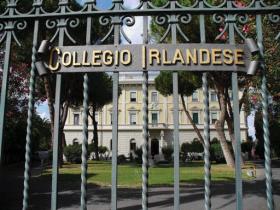
The Irish College in Rome, today the last remaining Irish seminary and training college in continental Europe.
The Irish College in Rome was founded in 1628 by the committed and resourceful team of Franciscan Luke Wadding and the cardinal protector of Ireland, the Jesuit Ludovico Ludovisi. It went through a series of administrations, but after a period of closure during the French occupation of Rome and its aftermath (late eighteenth/early nineteenth century) it emerged as an institution managed by the Irish dioceses and was awarded pontifical status in 1948. Today it is the last remaining Irish seminary and training college in continental Europe.
The archives tell an administrative and financial tale beginning with its foundation in 1628. Like many similar private archives, the Irish College’s are ostensibly a non-collecting repository, conserving papers judged legally or historically important that accrued in the normal run of business, but they are anything but narrow in character and assist in many lines of historical research. Some chance medieval acquisitions also extend the period of interest well beyond the College’s foundation. It is the nineteenth- and early twentieth-century incoming correspondence of the College’s rectors that has been drawing most researchers, however, and for that reason recent allocations of funding from the Dublin archdiocese are being used for this project. Digitisation as an archival measure for preservation is very much in its infancy and, despite the undisputed quality of the images, its use over microfilming is still a cause for debate. But it has the huge advantage that it also facilitates remote access, which is why it was chosen here. Since June 2007, 10,162 documents have been accessible to historians and the interested public upon registration, but so far that only covers the period from 1821 to 1874.
The rectors and their correspondence
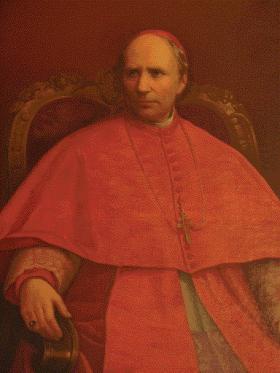
Paul Cullen, later archbishop of Dublin and cardinal. During his seventeen-year rectorship the Irish College expanded and student numbers doubled. (Pontifical Irish College, Rome)
The rectors’ official agency for the Irish bishops—and that extended to Irish clerics anywhere in the British colonies—was not just administrative. It very often became ‘political’, for example when Cullen had a hand in placing Irish bishops in India or North America. Apart, however, from isolated cases where a rector could bring his influence to bear, Roman business in the course of the nineteenth century increased everywhere: partly through the revolutionary development of communications and partly because the threat to anciens régimes throughout Europe created a greater emphasis on the role of the papacy. Even if no diplomatic action was expected from the
rectors, the letters soliciting errands at the Curia, those from former students, or those from lay people with family gossip or in thanks for favours obtained (e.g. arrangements of papal audiences) very often contain reflections on events back home. This, of course, depended on the correspondent’s familiarity with the rector.
It is easy to anticipate from the two men’s periods of office that the letters will treat the diverse economic, social, national and religious challenges then faced both in Ireland and in Italy: we are dealing with the period immediately after Catholic Emancipation, and the papers reflect aspects of all public events and movements in Ireland, as well as giving private commentary on the Italian risorgimento (unification) and its effects on the papacy from an Irish point of view. O’Connell’s repeal movement, for instance, finds copious illustration. The only letter in his own hand (9 May 1842) submits to Cullen’s judgement sixteen reasons for striving for the repeal of the Union—mentioning the £6 million of Irish revenue leaving the country each year, which strikes such a chord from our knowledge of the imminent famine—and asks the rector to obtain the blessing of Paul IX for his endeavours. Likewise, the Land War and the Plan of Campaign, the rise of Fenianism, the Irish Party’s striving for Home Rule and the disastrous ‘Parnell affair’ are naturally topics of the day that warrant a correspondent’s personal comments, or the more pointed discussion by an ecclesiastic who wishes to impress on the rector the way to forge ahead that would be favourable, or least damaging, to the Irish church. Also, the geographical spread is very wide, with Irish clergy writing from colonies and many missionary fields, but particularly from North America, Australia and New Zealand.
Paul Cullen (1834–49)
Of the two, Paul Cullen is the better known for being the first Irishman to receive a cardinal’s hat in 1854, and notorious perhaps for his tenure as archbishop of Dublin: the words ‘ultramontanist’, ‘conservative’ and ‘uncompromising’ describe his old-style rule over a church that he was sent by Rome to reform. Having previously spent 30 years in the Rome of Gregory XVI and Pius IX, his allegiance to Rome in matters administrative and political (he recruited the Irish papal brigade in 1859–60 and raised £80,000 for Pius IX) is unsurprising. During his rectorship of seventeen years, the Irish College expanded and student numbers doubled to over 40 in his first year in charge. He also has the higher profile in the archives: after his return to Ireland in early 1850, and particularly on being appointed archbishop of Dublin in 1852, he wrote copiously to his erstwhile ‘apprentice’ and successor as rector, Kirby. In some years he wrote as often as twice a month, with the range of topics and degree of confidentiality proving their very good working relationship during their fourteen years of collaboration. For anybody interested in Irish church politics during his episcopate these papers are of immense interest.
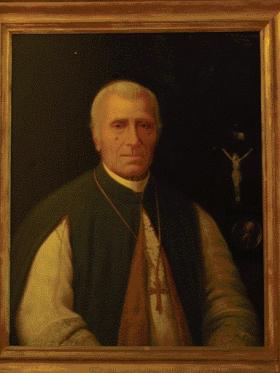
Tobias Kirby—as a former classmate and friend of Pope Leo XIII he was sure to find open doors at the Vatican. (Pontifical Irish College, Rome)
Tobias Kirby (1849–91)
Tobias Kirby was undoubtedly the more ‘Roman’ since he outdid his more illustrious predecessor (to whom he was devoted) in his 69 years of residency in the city. It seems he only returned home to Ireland twice in that period, and he remained as rector emeritus after his retirement in 1891, dying four years later. While not comparable to Cullen as regards administrative gifts and sheer drive, he steered the course of the national seminary in Rome at a time when the agent in Rome of any national hierarchy was becoming an indispensable, and indeed a powerful, figure. As a former classmate and friend of Pope Leo XIII he was sure to find open doors at the Vatican, and was rewarded for this connection in 1885 with a titular archbishopric (Ephesus). His gifts lay mostly along the lines of seminarian formation, devotions and spiritual guidance; there are hundreds of letters from private confessants, often Italian nuns. Patrick Corish has judged him ‘the soul of discretion’ and ‘a good man for a bishop to trust his affairs to’, inviting the type of confidential statements that can be found in the archives. It does happen on occasion that a correspondent urges Kirby to burn his despatch on reading it, while the letter survives for us to gauge the sense of drama behind the request. Former Irish College rector John J. Hanly summarised the two men’s perspective on national events from a distance:
‘Long before the birth of electronic communications, these men were well-informed on church affairs in these countries and enjoyed a perspective on them often denied to those who were geographically much closer.’
Correspondents, style and subjects discussed
Most of the ‘politically charged’ documents are written by fellow ecclesiastics—Daniel O’Connell’s single letter is the prominent lay exception. Among the prominent clerics and religious of the time represented are Archbishop McHale (‘the Lion of Tuam’), Father Mathew of Cork, Don Giovanni Bosco of Turin, the indefatigable Sister Margaret Francis Claire Cusack of Knock and Kenmare (‘the Nun of Kenmare’), and Archbishop William Walsh of Dublin.
Major events, as sketched above, find their way into the correspondence in ways dictated by the writers’ intentions: wanting to impress that a preferred line of action be taken at the Vatican, a fellow ecclesiastic would offer considered statements and well-set-out arguments. For instance, in June 1854 the bishop of Down and Connor, Cornelius Denvir, argues persuasively against the recommendation that he establish religious houses to address the shortcomings in Catholic education in his diocese: listing real and planned Orange acts of transgression against visible Catholicity, he makes clear that the time is not ripe for that. He describes the instance when O’Connell came to speak in Belfast in 1841: a mob of 5,000 lay in ambush for him, shot an effigy of him through with 500 musket balls, and finally attempted to kill him in his hotel, where dragoons were ready to defend him at sword point.
Drama is also provided by Fr John Miley, Daniel O’Connell’s friend and private chaplain, who writes to Cullen during their journey towards Rome in 1847 during the Liberator’s last illness; he died on 15 May in Genoa, and a letter written the next day by Miley describes his last prayerful hours, and first mentions his bequest of his heart to Rome, since he could not reach it in person. A marble monument in the College once contained that secular relic.
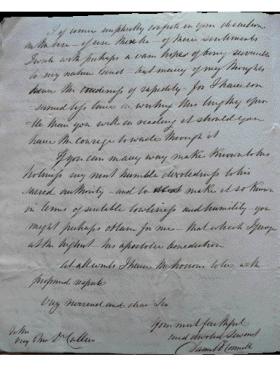
Most of the documents are written by fellow ecclesiastics; this letter from Daniel O’Connell to Paul Cullen is the prominent lay exception. (Pontifical Irish College Archives)
The Famine is brought into stark relief, and Cullen and Kirby were the men in Rome to represent matters to the pope. For instance, one letter of 15 December 1846 from Bishop Maginn of Raphoe, written in Buncrana, begs to postpone devotions called for by Pius IX: ‘our poor people throughout the length and breadth of this diocese are in a state of actual starvation . . .’. Frost and snow had set in, and he judges that even despite their long experience of persecution and misery this calamity exceeds any other in intensity. ‘You see that for the present it would be impossible for them to attend to the good works prescribed by His Holiness’s rescript.’ At the end of the letter he cannot help returning to this reality, far removed from papal entreaties for repentance: ‘. . . the scenes here are heart-rending and the fate of the dead is being envied by the living’. In early 1847 Paul Cullen was to preach at a triduum under the aegis of Pius IX and the Congregation of Propaganda Fide, held to raise funds for Irish famine victims.
But, as in any collection of letters written to men of influence, the formal statements are complemented by casual remarks that are valuable precisely for their lack of reflection and that can light up the contemporary situation back home, whether in Ireland or in one of those British colonies. Thomas Moloney, a former student and now chaplain in the Crimea in the 1850s, writes two lengthy letters—‘epistles’ better describes them—to Rector Kirby from Constantinople and from Sebastopol, listing the awful casualties around him and employing the language of his time for the ill deeds that brought this calamity on England. Likewise, an English lady correspondent of Kirby, E. C. Nimmo, emerges from letters a devout convert, alternately sending Kirby a cure to be boiled up with a bottle of wine, ‘for I know how kind you are to your servants, and how often you will go without anything you need rather than give them trouble’, and asking for a few kind words from the pope appreciating her cousin Gladstone’s work for Ireland, and ‘because of William’s great respect for His Holiness’. The last one is undated, but must belong in the late 1880s or early 1890s.
The papers are for the most part handwritten, usually incoming correspondence among which few drafts of outgoing papers survive, and often with newspaper or other enclosures. Over 80% are in English, but when the rectors dealt with Vatican authorities or private individuals they received letters in Italian or Latin (the latter usually quite formulaic); some private letters are also in French. Given the men’s origins in Kildare and Waterford, it is no surprise that there is not a single item in Irish.
Beyond Cullen and Kirby
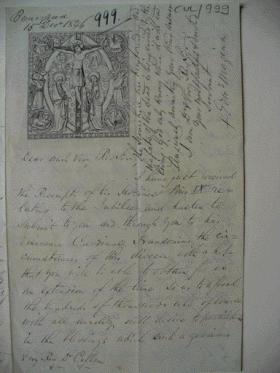
A letter from Buncrana (15 December 1846), from Bishop Maginn of Raphoe, begs to postpone devotions called for by Pius IX because ‘our poor people throughout the length and breadth of this diocese are in a state of actual starvation . . .’. (Pontifical Irish College Archives)
The two following rectorships were of shorter duration, and for that reason, and possibly for the lack of personal dynamism, the ensuing correspondence is of lesser political interest. After that, however, there emerge two figures of considerable profile and attraction for the historian: Limerickman Michael O’Riordan (1905–19) and Wicklowman John Hagan (vice-rector from 1904, rector 1920–30), both in their respective ways ardent nationalists. The papers of both men are objects of intense research, and credit has to be given to Dermot Keogh of UCC for having brought the Hagan papers in particular to the fore since the mid-1980s. Any future application for funds to digitise will necessarily focus on these two, and will serve academics and the interested public alike in a similar way to the Cullen–Kirby project.
Vera Orschel is the archivist at the Pontifical Irish College, Rome.
Further reading:
J. J. Hanly, The Irish College, Rome (Norfolk, 1989).
D. Keogh and A. McDonnell (eds), The Irish College and its world (Dublin, 2008).
www.irishcollege.org/archives on the holdings, for information on registration for the website, and on visiting the archives.
















